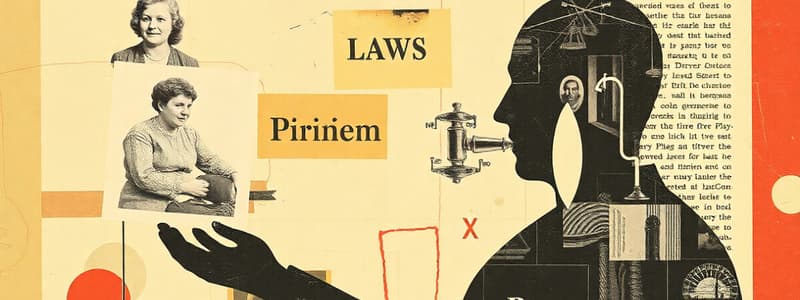Podcast
Questions and Answers
Which of the following best describes the primary function of system software?
Which of the following best describes the primary function of system software?
- Managing specific tasks like word processing.
- Handling financial data.
- Controlling the basic functions of a computer. (correct)
- Creating operational instructions.
Which of the following is the MOST direct outcome of an organization possessing intellectual property assets?
Which of the following is the MOST direct outcome of an organization possessing intellectual property assets?
- A decreased emphasis on employee involvement.
- The creation of an organizational monopoly. (correct)
- An increased need to collaborate with competitors.
- A reduced focus on market research.
What is the significance of patents and copyrights in the context of organizational assets?
What is the significance of patents and copyrights in the context of organizational assets?
- They encourage the sharing of trade secrets.
- They are proof of legal ownership. (correct)
- They ensure low-cost leadership.
- They protect brand image.
How does an organization benefit from safeguarding corporate assets through legal mechanisms?
How does an organization benefit from safeguarding corporate assets through legal mechanisms?
Which of the following is the MOST important characteristic of 'collective expertise' within an organization?
Which of the following is the MOST important characteristic of 'collective expertise' within an organization?
How do individuals with historical knowledge contribute as human resource assets?
How do individuals with historical knowledge contribute as human resource assets?
What distinguishes 'human-centered assets' from merely having mature employees?
What distinguishes 'human-centered assets' from merely having mature employees?
What is the MOST significant result of possessing strong human resource assets?
What is the MOST significant result of possessing strong human resource assets?
How is customer loyalty BEST described in the context of marketing assets?
How is customer loyalty BEST described in the context of marketing assets?
What is the PRIMARY importance of efficient distribution channels for market control?
What is the PRIMARY importance of efficient distribution channels for market control?
Apart from denoting ownership, what is another advantage that branding provides?
Apart from denoting ownership, what is another advantage that branding provides?
What is the significance of a well-known company name in terms of market dominance?
What is the significance of a well-known company name in terms of market dominance?
Which of the following describes one of the primary characteristics of dynamic organizational cultures?
Which of the following describes one of the primary characteristics of dynamic organizational cultures?
Why are high-involvement work practices considered infrastructure assets?
Why are high-involvement work practices considered infrastructure assets?
How does an organization benefit from a streamlined structure that facilitates communication?
How does an organization benefit from a streamlined structure that facilitates communication?
What key role does technology play in providing a comparative advantage to organizations?
What key role does technology play in providing a comparative advantage to organizations?
Which of the following BEST describes competency learning?
Which of the following BEST describes competency learning?
In the context of classifying competencies, what differentiates 'functional competencies' from 'core competencies'?
In the context of classifying competencies, what differentiates 'functional competencies' from 'core competencies'?
What is the primary purpose of 'strategic enhancement' in managing intellectual capital?
What is the primary purpose of 'strategic enhancement' in managing intellectual capital?
How does 'competitive innovation' contribute to creating bargaining power for an organization?
How does 'competitive innovation' contribute to creating bargaining power for an organization?
Flashcards
Intellectual Property Assets
Intellectual Property Assets
Assets resulting from mental activities, like ingenuity, brilliance, or creativity.
Forms of Intellectual Property
Forms of Intellectual Property
Creations like trademarks, software, copyrights and patents.
Trademarks
Trademarks
Service marks, trade names, designs, logos, seals, and symbols.
Software
Software
Signup and view all the flashcards
Organizational Monopoly
Organizational Monopoly
Signup and view all the flashcards
Human Resource Assets
Human Resource Assets
Signup and view all the flashcards
Competency
Competency
Signup and view all the flashcards
Success Factors
Success Factors
Signup and view all the flashcards
Core Competencies
Core Competencies
Signup and view all the flashcards
Functional Competencies
Functional Competencies
Signup and view all the flashcards
Managerial Competencies
Managerial Competencies
Signup and view all the flashcards
Differentiating Existing Products
Differentiating Existing Products
Signup and view all the flashcards
Reinventing Products
Reinventing Products
Signup and view all the flashcards
Continuous Experimentation
Continuous Experimentation
Signup and view all the flashcards
Company Name Value
Company Name Value
Signup and view all the flashcards
Marketing Assets
Marketing Assets
Signup and view all the flashcards
Infrastructure Assets
Infrastructure Assets
Signup and view all the flashcards
Streamlined Structure
Streamlined Structure
Signup and view all the flashcards
Information Technology
Information Technology
Signup and view all the flashcards
Competitive Innovation
Competitive Innovation
Signup and view all the flashcards
Study Notes
Intellectual Property Assets
- Assets resulting from activities of the mind
- Products of research, ingenuity, brilliance, creativity, or accidental discovery
- Examples include trademarks, service marks, software, copyrights, patents, and trade secrets
- Trademarks encompass service marks, trade names, designs, logos, seals, and symbols
- Software is organized information for computer operations with two classifications:
- System software controls basic computer functions
- Application software handles common tasks with programmed manuals and instructions
- Original literary, music, and art compositions are unique
- Trade secrets involve all types of information, technical or otherwise, like company philosophy and data
- Intellectual property outputs include unique designs, innovative products, and inventions
- Protected by law, giving exclusive rights to individuals/organizations via patents or copyrights, enabling a monopoly
Organizational Monopoly
- Created when an organization possesses intellectual property assets, leading to a competitive edge
- Allows the organization to optimize intellectual property and enjoy associated benefits – Cultivates a reputation for innovation – Increases internal efficiency, productivity, and employee motivation
- Helps to draw financial returns from intellectual property through production, utilization, and sales – Offers exclusive rights to produce and sell research results
- Safeguards corporate assets through legal means for brand protection and trade secrets – Government ensures intellectual property rights through legal enforcement, prohibiting copying – Patents and copyrights act as legal proof of ownership
- Creates opportunities for low-cost leadership and enhances competitive strength
Human Resource Assets
- Encompass expertise, traits, capabilities, skills, and organizational human-centered assets
- Expertise includes specialized knowledge and academic achievements
- Skills include unique and forward-looking professional competence
- Knowledge in various fields does not automatically equate to intellectual capital
- Individuals become valuable assets when they are smart, strategic, and have environmental knowledge
- Historical knowledge is valuable because it is from people that have been within the company for a long time seeing the evolution of the company
- Key personal traits include leadership, ingenuity, problem-solving capabilities, and adaptability – Also includes energy, initiative, industry, and integrity
- Managerial, entrepreneurial, and competency assets include effective planning and business expertise – Also includes competency in communication, IT, and practical qualifications
Human-Centered Assets
- Involve mature employees and collaborative teamwork
- Employee qualities include high emotional intelligence, self-awareness, and strong interpersonal skills
- Synergistic relationships among employees, management, and stakeholders
- Cultivate commitment, social enrichment, and competitive advantage
Human Resource Leverage
- Arises from human resource assets, creating a competitive edge
- "Expertise" assets consist of educational attainment, professional competence, and relevant knowledge
- Personal qualities enhance organizational temperament
- Managerial and entrepreneurial skills promote effectiveness
- Human-centered qualities facilitate opportunity
- Recognizing and developing human resources is crucial
- Employee departure results in asset loss
Marketing Assets
- Intangible assets such as brands, names, and loyalty
- Brands provide market supremacy – Well-recognized brands promote substantial sales – Examples include "Colgate", "Kodakan", and "Xerox"
- Company names can be market assets by virtue of popularity
- Customer loyalty assists organizations in gaining market share by long term support and relationships
Distribution Channels
- Efficient channels do not assure market control if they are unstructured
- Organized channels enable expansion and attract customers
- Strategic and collaborative alliances are essential for market ascendancy
Market Dominance
- Brought about by effective brand marketing and efficiency
- Effective branding creates product awareness and advertising advantages
- A well-known company name enhances financial worth
- Repeat business from customer loyalty creates an advantage
- Optimized sales come from efficient movement of goods/services to the public
Infrastructure Assets
- Positive organizational features like management philosophy and structure
- A lean organizational structure streamlines tasks and reduces bureaucracy
- Dynamic organizational cultures have values that translate into positive attitudes – Includes shared interests and emotional balance – Has organizational philosophies and ethical practices
- Managerial practices with quality standards enhance competitiveness
- Technology is the application of knowledge
Comparative Advantage
- Streamlined structure improves communication
- Aligning beliefs fosters a collaborative environment
- Management philosophies contextualize organizational direction
- Commitment to ethical practices enhances organizational value.
- High involvement increases performance
- Streamlined processes minimize costs
- Quality standards like quality policy improve operations
- IT transforms functionality in various ways
Asset Management Strategies
- Managing the assets of an organization to improve its valued resources
- Competency involves knowledge, attitudes, and skills aligned with the vision
- Well-defined job descriptions provide a performance framework and assures employees have proper skills
- Competency streamlines management - improving employee skills and efficiency
- Competency assists with recruitment and promotion
Classifying Competencies
- Realization of a company success is dependent on the vision and its employees performing
- Employee expertise is dependent on rank an alignment with job descriptions
- Competencies are classified as either core, functional, or managerial
- Core competencies are the basic standards that all employees must have
- Functional competencies are for specific jobs in areas like marketing and tech
- Managerial competencies involve administrative/attitudinal skills
Widening the Horizon
- Strategic advancement is critical to competitive advantage
- Computers can broaden business opportunities
- Companies should appreciate the value of knowledge and communication to improve
- Creating a database of existing clients, vendors and competition improves performance
- Undergoing systematic computer recording
- Engaging in e-marketing
- Take advantage of deals offered by supplier
- Training helps enhance and generate knowledge
- Employees must be encouraged to develop themselves and share knowledge
- Need to recognize the knowledge of experts within the fields
- Prepare employees to adopt to attitudinal change
- Resources are access to market information and intellectual property
- Networking through strategic alliances is important
- Company culture should constantly evolve
Competitive Innovation
- Ensures sustainability and advantage
- Creating and re-engineering new ideas
- Brings a paradigm shift from old mindsets to new
- Encourage a synergistic outlook
- Should be tailored to the given innovation scenario
Innovation Scenarios
- Consists of ways to innovate
- Differentiation of existing products
- Reinventing products and services
- Continuous experimentation
- Applying technologies
- Change the business
- New products to futurize the org
- Widening the breadth/depth of intellectual property
- Competencies are more effective than seniority, and create bargaining power
Studying That Suits You
Use AI to generate personalized quizzes and flashcards to suit your learning preferences.



